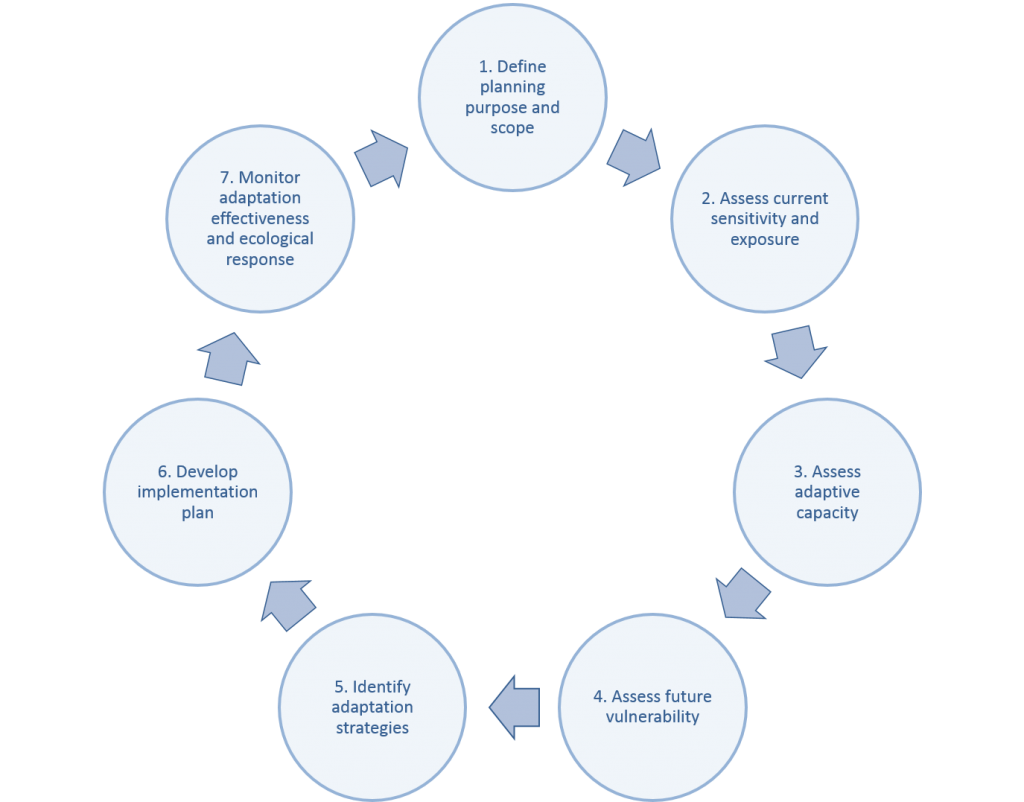Vulnerability Assessment Components
The following graphic illustrates the key components of a vulnerability assessment ref and can be used to help incorporate climate considerations into an existing planning and decision-making process.
Note: Vulnerability assessments are most effective when they are incorporated into an existing planning or management process. Indeed, they follow many of the same phases of standard resource management planning efforts (e.g., scoping, stakeholder engagement, implementation, monitoring, adaptive management).

1. Define assessment purpose and scope
- Guides the activities of developing and implementing adaptation policies and plans including establishing the purpose, outcomes, and stakeholder engagement. This may include:
- assessment purpose and expected outcomes
- existing conservation goals and targets
- geographic scope and time frame
- key participants and partners
- resource needs and availability
2. Assess sensitivity and exposure
Determines the exposure and sensitivity of conservation targets including human communities to climate change, variability, local stressors, and ecological change. Combined these provide the overall potential impact to social, economic, and ecological targets by climate change. This may include:
- magnitude and rate of ecosystem changes (e.g., from climate data and local knowledge)
- existing local stressors on targets, ecosystem health, and ecosystem services
- differences in how humans may be affected by climate impacts (e.g., based on occupation, gender, health, education, age)
3. Assess adaptive capacity
Identifies the key factors affecting adaptive capacity and assesses the ability of communities and ecosystems to cope with and respond to the combined effects of local stressors and climate change and variability. This may include:
- effectiveness of and access to social networks (e.g., women’s groups, church groups, youth groups)
- local knowledge and practices to cope with climate events and impacts
- community awareness of climate change
- ability to plan, learn, and reorganize in response to hazards/climate events
- access to financial and material resources and information to cope with risk

A community in Yap, an island in the Federated States of Micronesia, discusses agricultural resources vulnerable to climate change. Photo © TNC
4. Assess future vulnerability
Involves developing scenarios of future climate, and potential changes in exposure, sensitivity, and adaptive capacity. This may include:
- climate projections combined with local knowledge of climate events and impacts
- scenarios of possible changes in climate, socioeconomic, and environmental conditions
- vulnerability of current socioeconomic/environmental conditions to future climate change
- uncertainty of climate change and associated impacts
5. Identify adaptation strategies
Involves the development and prioritization of adaptation strategies and policies that reduce exposure or sensitivity and/or build adaptive capacity. This may include:
- adapting current management strategies or developing new ones, to more comprehensively address vulnerabilities to climate impacts
- prioritization of adaptation strategies based on criteria (e.g., community acceptability, costs/benefits, possible adverse effects, effectiveness, feasibility, and potential impacts)
- barriers to adaptation and ways to overcome barriers
6. Develop implementation plan
Identifies core components of an implementation plan including resources and the incorporation of adaptation strategies into conservation and development policies, programs, and plans. This may include:
- timeline of activities with deliverables and dates
- identification of who will lead each activity and resources needed
- integration of adaptation strategies into existing policies, programs, plans
- measures to assess performance of adaptation strategies
7. Monitor adaptation actions and revise conservation goals
Includes the monitoring and evaluation of adaptation strategies and changes in conservation target and adaptive capacity of target community, reassessment and revision of adaptation strategies, and conservation goals based on evaluation results/new information. This may include:
- clarifying goals and purpose for assessment and evaluation
- selecting relevant indicators and methods for monitoring
- developing data management plan, analysis, and reporting
- communicating evaluation results
